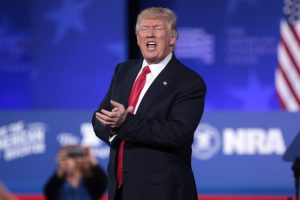by Robert E. Hunter
The false alarm of a nuclear attack on Hawaii this past Sunday has been dismissed as human error. In response, the Trump administration has sought to insulate the Pentagon and the military commands. The deputy White House press secretary said, “This was purely a state exercise.” Responsibility for action has been given to the Federal Communications Commission, which is “launching a full investigation.”
But treating this event as a routine malfunction misses the broader implications, big time. For the first time in a quarter-century, the government must undertake a root-and-branch reconsideration of nuclear policy, not just in military terms (this is being done), but regarding political relationships and strategies in crises, now notably with North Korea (this has not been done).
The widespread panic in Hawaii might have been less severe if President Donald Trump had not been brandishing nuclear weapons in his standoff with North Korean leader Kim Jong Un—as though this is a video game rather than a potentially deadly confrontation with a regime that has a growing nuclear arsenal and the potential ability sometime soon to attack at least some parts of the United States. “I too have a Nuclear Button, but it is a much bigger & more powerful one” may be stock-in-trade of the grade-school playground. But it has no place when history’s most potent weapons are concerned, especially in a foreign-policy crisis of indeterminate dimensions involving an adversary about whom the United States knows far less than it did of the Soviet leadership at any point during the Cold War.
Trump has chosen to ramp up threats to North Korea, even though it must know that it could be, in the words of US ambassador to the United Nations Nikki Haley, “utterly destroyed.” On at least two prominent occasions, Trump has directly undercut Secretary of State Rex Tillerson, who was taking the sensible course of trying to see whether there can be negotiations with North Korea without “preconditions,” which is code for “you have to make concessions before the talking starts.”
Last October, Trump let it be known that he was considering whether to put nuclear-armed B-52s back on 24-hour alert, for no obvious reason than increasing psychological pressure on Pyongyang. In the process, however, he increased concern on the part of key American allies whether the president truly knows what he is doing or whether this action is on a par with his off-the-wall twittering that, uniquely in American presidential history, has led some competent medical people to question his emotional balance.
Neither the Pentagon’s leadership nor the relevant US military commands have sought to reassure the American people that what happened in Hawaii does not in any way call into question the redundant controls against error involving the use of nuclear weapons. This has not been helped by widespread questioning whether the president has the authority, at will, to order their use. Outside of a major international crisis, it most likely is not, but no one can be sure of this president’s scope of action.
What happened in Hawaii should mandate a thorough reconsideration of all nuclear-related issues, which the civilian thinktank community has largely ignored since the Cold War’s end. In the government, this task should not just be entrusted to military leaders, who now dominate the administration’s cabinet level positions. An added problem is that all of us who ever had senior-level responsibility for dealing with questions of nuclear deterrence have long since left government service.
Regarding North Korea, the Trump administration continues to promote the longstanding US goal, in the words of the 2017 National Security Strategy, “to achieve complete, verifiable, and irreversible denuclearization on the Korean Peninsula.” This is fiction. Kim and his cohorts know full well that “regime change” continues to be US policy, and they can see what happened in Libya and Iraq. They’ve also watched as the Trump administration has increased pressures on Teheran, despite the Joint Comprehensive Plan of Action that puts off Iran’s getting the bomb for at least a decade.
Getting rid of all nuclear weapons on the Korean Peninsula will not happen short of a comprehensive agreement on the future of the two Koreas. Even then, Kim would be a fool to back off on the nuclear progress he has already made. Perhaps some diplomatic possibilities remain to deescalate the conflict, not just between the two Koreas as in the current, limited Olympic diplomacy, but between the DPRK and the United States. No such initiatives are on the horizon. Thus, the US has no choice but to bring out of storage, update, and articulate mutual deterrence theory and practice that became obsolete when the Cold War ended.
The Trump administration also needs to stop inflammatory rhetoric that is scaring US allies around the world far more than it could possibly scare North Korea, which does not need to be reminded of US military power. And it needs to demonstrate to the American people that what happened in Hawaii last Sunday cannot happen to any of the controls over the US nuclear arsenal. An appeal to trust is not good enough.
Photo: Duck and cover drill in U.S. classroom in 1962 (Wikimedia Commons)





